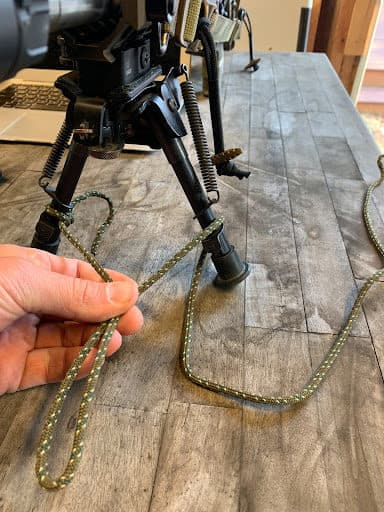
Here at Ridgeline, we’re all about performance. Faster and more accurate sum up the end state of nearly all of our classes. Something you’ll find attached to all of our Instructor’s bipod equipped rifles is a short piece of 550 or paracord. We often get asked what is it’s purpose. The answer is simple; fast, single-hand bipod deployment. This is a huge level up when running Designated Marksman Rifles (DMR/SPR) in our Scoped Carbine or LE Designated Marksman classes, and also proves extremely handy in our Long-Range Precision Rifle and Police Marksman or Sniper courses. Below is a step by step tutorial for you to make your own bipod strap… #fieldcraft
To set up the bipod paracord hack you will need the following:
- 24” piece of paracord, color optional
- Lighter
- Scissors or knife

I start by tying a timber hitch on one leg first, leaving roughly 3 inches of loose end beyond the timber hitch. Simply put, loop your loose end through the bight 2 times.

This 3 inch piece will be important when we tie our stop knot later at the last step. From here I take the working end of the rope and create the “tether” length that I want. This will take a few attempts to find what works best for you and your weapon system.

Work the bight around the outside of the bipod leg, this will mean the knot gets tighter with every pull and will also tend to lead towards the front of the gun. I try to hold the tether in one hand while I get the hitch started with my other hand. Ambi-tying so to speak. From here you just need to make adjustments to the length of the tether to your desired pull.

From here I tie the overhand knot in the center of the tether that I have created and check the overall setup to make sure it feels good. The snap of the bipod legs should be fairly easy when you pull it, you don’t want this long tether that is gonna snag on everything but also keep in mind you want it long enough to be able to grab it quickly and securely.

I normally tie my stop knot at this point, It’s just an overhand knot that is designed to stop and create tension in the hitch itself as it’s pulled. I snug that up and once everything is good to go, I cut loose ends and melt everything down with a lighter.
Hopefully this helps you guys out when deploying that bipod and gets you behind the gun a little quicker.



